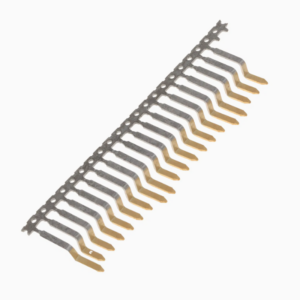Characteristics:
– Place of Origin:Xiamen, China
– Model Number:OEM
– Materials:Copper, Stainless Steel, Aluminum
– Process:Progressive Stamping
– Keyword:Custom Metal Stamping Parts
– Applications:Communication, Medical, LED, etc.
– Surface Treatments:Nickel Plating, Zinc Plating, Tin Plating, Chrome Plating
– Service:Customized OEM
– Item:Machining Metal Part
– Tolerance:±0.03mm
– Certificates:ISO, TS16949, ROHS
Introduction:
Metal Stamped LED Leadframes are critical components used in LED packaging. Manufactured by precision metal stamping, these leadframes are the structural and electrical foundation of the LED. They support the LED chip, facilitate electrical connections, and improve heat dissipation to ensure optimal performance and longevity of the LED device. By providing a reliable framework, they are critical to applications ranging from consumer electronics to automotive lighting and industrial displays.
Common Finishes for Metal Stamping
- Plating
– Description:Electroplating involves coating the metal with a thin layer of another metal such as nickel, zinc, or tin. This enhances corrosion resistance, electrical conductivity, and appearance.
- Powder Coating
– Description:A dry powder is applied electrostatically to the metal surface and then cured under heat. This finish provides a durable, high-quality, and uniform coating that is resistant to scratches, chipping, and fading.
- Anodizing
– Description:This electrolytic process is typically used for aluminum, creating a thick oxide layer that enhances corrosion resistance, surface hardness, and aesthetic appeal. Anodizing can also add color to the metal.
- Painting
– Description:Applying liquid paint to the metal surface can offer aesthetic variety and additional protection against environmental factors. Different types of paint can be used depending on the required finish and durability.
- Passivation
– Description:A chemical treatment that removes free iron from the surface of stainless steel, improving its corrosion resistance. This finish is essential for parts exposed to harsh environments.
- Polishing
– Description:This mechanical process smooths the metal surface to achieve a shiny, reflective finish. Polishing is often used for decorative purposes and to improve the metal’s resistance to corrosion and wear.
- Brushing
– Description:Brushing creates a uniform, parallel grain texture on the metal surface. It is often used for aesthetic purposes, providing a satin-like finish that can hide fingerprints and minor scratches.
- Galvanizing
– Description:A protective zinc coating is applied to steel or iron to prevent rusting. Galvanizing is commonly used for outdoor and industrial applications due to its excellent corrosion resistance.
- Etching
– Description:This chemical process selectively removes material to create designs or patterns on the metal surface. Etching is used for both functional and decorative purposes, providing precise and intricate details.








-300x300.png)




Reviews
There are no reviews yet.